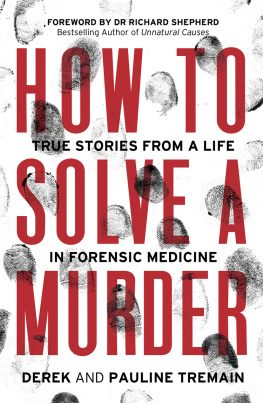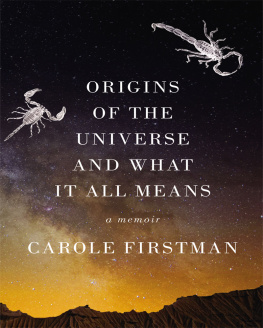THE DEATH OF INNOCENTS
A Bantam Book/October 1997
All rights reserved.
Copyright 1997 by Richard Firstman and Jamie Talan.
The authors and publisher gratefully acknowledge permission for use of the following material: Excerpts from Pediatrics, Volume 50, 1972, and Volume 52, 1973, reproduced by permission of Pediatrics.
No part of this book may be reproduced or transmitted in any form or by any means, electronic or mechanical, including photocopying, recording, or by any information storage and retrieval system, without permission in writing from the publisher. For information address: Bantam Books.
LIBRARY OF CONGRESS CATALOGING-IN-PUBLICATION DATA :
Firstman, Richard.
The death of innocents / Richard Firstman and Jamie Talan.
p. cm.
eISBN: 978-0-307-80698-7
1. FilicideUnited StatesCase studies. 2. Van Der Sluys, Stephen. 3. Hoyt, Waneta, 1946 4. Munchausen syndrome by proxyUnited StatesCase studies. 5. Sudden infant death syndrome.
6. MurderUnited StatesInvestigationCase studies.
I. Talan, Jamie. II. Title.
HV6542.F57 1997
364.152309747dc21 97-3209
Bantam Books are published by Bantam Books, a division of Bantam Doubleday Dell Publishing Group, Inc. Its trademark, consisting of the words Bantam Books and the portrayal of a rooster, is Registered in U.S. Patent and Trademark Office and in other countries. Marca Registrada. Bantam Books, 1540 Broadway, New York, New York 10036.
v3.1
A simple child,
That lightly draws its breath,
And feels its life in every limb,
What should it know of death?
W ILLIAM W ORDSWORTH
In medicine one must pay attention not to plausible theorizing, but to experience and reason together.
H IPPOCRATES , P RECEPTS
Contents
P ART O NE
Burial Grounds
Discovery consists of seeing what everybody has seen and thinking what nobody has thought.
A LBERT S ZENT -G YRGYI
Y ears later, it seemed a perverse irony that the unearthing had begun with the conception of a baby.
It was on a spring day in 1994 that the saga and the first hints of its ramifications emerged from the burial ground of distant memory, but it could be said that the entire intricate affair had begun to percolate at one particular moment nearly a decade before: late on the afternoon of April 4, 1985, when Stephen Van Der Sluys came home to find two men in coats and ties talking to his wife at the front door.
In the upstate New York community of Canandaigua, deep in the Finger Lakes region between Rochester and Syracuse, Van Der Sluys lived with his wife and children, trying to outrun the darkness of his well-hidden past. The men at the door were not here about the past, however, but about a recent and much more easily grasped situation. This was a simple case of sexual impropriety, and the visit by a pair of New York State Police investigators came as no surprise to Van Der Sluys. He had set things in motion himself by walking over to the teenage girls house and confessing his indiscretions to her father.
Guess youre looking for me, Van Der Sluys called out as he walked up from the driveway. The investigators turned to see a small man, no more than five-five, five-six, who struck them as bearing a resemblance towhat was that actors name? Robin Williams, that was it. They nodded their hellos and identified themselves for the record; Van Der Sluys asked how they were doing. One of the detectives, Bob Beswick, a mild man who had been out of uniform only a few months after twenty-two years of chasing speeders on the Thruway, found Van Der Sluyss casual good humor disarming. Long afterward, Beswick would remember glancing at Van Der Sluyss open-faced wife, Jane, hearing the drone of the television occupying the couples two small children inside, and wondering what it was about a guy like this. He would smile uncomfortably at the memory of how little he really knew about Van Der Sluys that day.
Would you mind coming down for a talk? Beswick asked. Sure, Van Der Sluys said, hed talk to them. He told Jane hed see her later. The investigators led the way to their standard-issue Chevrolet and showed Van Der Sluys to the rear seat. Beswick was set to back out the driveway for the fifteen-minute trip to troop headquarters when Van Der Sluys stopped him. Why dont we just talk right here? he suggested.
All right, Steve, Beswick said, putting the car in park and switching off the ignition. We can talk here. He turned to face Van Der Sluys. You know why were here.
Uh-huh, Van Der Sluys said.
Have you had sex with that girl? Beswick asked.
Yes.
Did you get her pregnant?
Yeah, I did.
And then Van Der Sluys, with scant urging, told the detectives where and when and how many times and in what fashion, a tidy chronicle of statutory rape that they were later amazed to find matched up almost perfectly with the diary his sixteen-year-old mistress had been keeping. Having unburdened himself in the driveway, Van Der Sluys sat back for the brief ride to the booking room at the county jail. From the doorway, Jane Van Der Sluys watched somberly as the car pulled away. She was pregnant with their sixth child.
Bill Fitzpatrick, the chief assistant district attorney of Onondaga County, was swimming in work that spring. There were so many murders splashing across the Syracuse papers, sensational trials leading the local TV news, that the prosecutor might have thought he was back home in Brooklyn. Fitzpatrick had tried seven murder cases in 1984, his first full year as Dick Hennessys top homicide man, and more were on the way. There were also the internal politics of the D.A.s office to be aware of, and occasionally to worry about. With Hennessy, you had to watch your back, even if you were one of the golden boysprobably more so. And from the day he had walked into the office right out of Syracuse Law in the spring of 1976, Bill Fitzpatrick was definitely one of the golden boys.
So Fitzpatrick had a few things on his mind during those months in 1985. But when word came from Syracuse police headquarters a block away that Stephen Van Der Sluys had turned up in a little town near Rochester, three counties and an hours drive west, and was sitting in jail for getting a teenager pregnant, Fitzpatrick was instantly intrigued by the possibilities. A New York City police detectives son, he was at heart a gumshoe in a lawyers suit, a prosecutor who sometimes found it difficult to let the sergeants do their jobs. This could have been trouble if not for the engaging way he got cops to think of him as one of them. He wanted solid police work, but hed take half a case, a less-than-sure thing, if he believed in it. An old case, especially. Bring him the abandoned files in their dusty cardboard boxes. Cases without conclusion, cases that knocked around, unsolved, unavengedthese were Bill Fitzpatricks kinds of cases.












